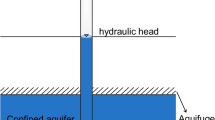Abstract
A newly developed towed transient electromagnetic (TEM) system is capable of measuring the electrical conductivity of the uppermost 5–10 m of sediments on the sea floor. The profiles of conductivity may be interpreted to give the porosity and likely texture of the bottom sediments. Recent tests of the system have demonstrated that data may be collected continuously in a surveying mode. Results from Knight Inlet, British Columbia, are in good agreement with sea floor samples from the area.
Applications for the system include the rapid identification of sediment types for dredging operations, geotechnical surveys, or reconnaissance mapping of Quaternary geology.
Similar content being viewed by others
References
Accerboni, E. and Mosetti, F., 1967. A physical relationship among salinity, temperature, and electrical conductivity of seawater.Bollettino Di Geofisica Teorica Ed Applicata 9:87–96.
Archie, G.E., 1942. Electrical resistivity as an aid in core analysis interpretation.Transactions of the A.I.M.E. 146:54.
Bornhold, B.D. and Prior, D.B., 1989. Sediment blocks on the sea floor in British Columbia fjords.Geo-Marine Letters 9:135–144.
Chave, A.D., Constable, S.C., and Edwards, R.N., 1991. Electrical exploration methods for the sea floor.Society of Exploration Geophysics Electrical Methods 2 (in press).
Chave, A.D. and Cox, C.S., 1982. Controlled electromagnetic sources for measuring electrical conductivity beneath the oceans. 1. Forward problem and model study.Journal of Geophysical Research 87:5327–5338.
Cheesman, S.J., 1989. A short baseline transient electromagnetic method for use on the sea floor.Research in Applied Geophysics, University of Toronto,46, 138 pp.
Cheesman, S.J., Edwards, R.N., and Law, L.K., 1990. A test of a short baseline seafloor transient electromagnetic system.The Geophysical Journal 103:431–437.
Cheesman, S.J., Edwards, R.N., and Chave, A.D., 1987. On the theory of seafloor conductivity mapping using transient electromagnetic systems.Geophysics 52:204–217.
Hamilton, E.L., 1974. Prediction of deep-sea sediment properties. In: Inderbitzen, A.L. (Ed.), Deep-sea sediments: Physical and mechanical properties. Plenum Press, New York. 1–43.
Jackson, P.D., Taylor Smith, D., and Stanford, P.N., 1978. Resistivity-porosity-particle shape relationships for marine sands.Geophysics 43:1250–1268.
Jupp, D.L.B. and Vozoff, K., 1975. Stable iterative methods for the inversion of geophysical data.Geophysical Journal of the Royal Astronomical Society 42:957–976.
Author information
Authors and Affiliations
Rights and permissions
About this article
Cite this article
Cheesman, S.J., Law, L.K. & Edwards, R.N. Porosity determinations of sediments in Knight Inlet using a transient electromagnetic system. Geo-Marine Letters 11, 84–89 (1991). https://doi.org/10.1007/BF02431034
Received:
Revised:
Issue Date:
DOI: https://doi.org/10.1007/BF02431034




